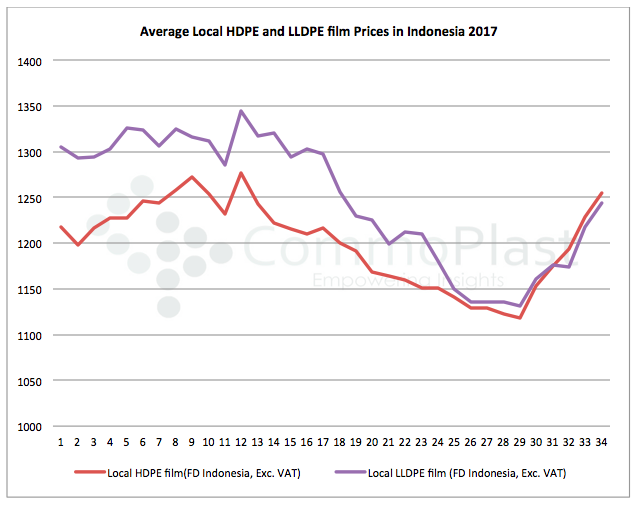

|
Limited supply pushes local PE market higher in Indonesia, resistance built upLimited supply pushes local PE market higher in Indonesia, resistance built up |
|
Local PE market in Indonesia has been following the downtrend for an extended period of time until late July, where improved demand and tighten local supply steered the market to the opposite direction.
As shown in the following diagram, local HDPE and LLDPE film prices, based on FD Indonesia, cash term technically took a drastic upswing over the past five weeks, regaining a large portion of the loses recorded in the past several months.

One of the reasons contributed to the rapid recovery is the recent surge in ethylene costs, stemming from limited availability and healthy demand from the Northeast Asia region. As a result, non-integrated producers are forced to cut operating rate since it is not economical to produce PE at the current costs.
In fact, Lotte Chemical Titan Indonesia decided to cut run rate to protect profit margins, leading the company to suspend all spot offerings while only fulfill 50% of contract orders. “Converters are rushing to distribution market to find materials following the producer’s announcement, however, insisting on previous prices. Traders are mostly having limited quantity on hand, hence it is likely that the firming trend would sustain in the coming weeks,” a trader said.
On an average, local HDPE and LLDPE film in Indonesia surged nearly $140/ton and $115/ton in five weeks, CommoPlast data showed, in which many converters find negative margins on end product sales. A flexible packaging manufacturer said, “We could not transfer higher raw material costs to end product prices, and thus, even with moderate inventories on hand, we only source material hand to mouth basis.”
Buyers are active is asking for offers, though the number of actual deals reported is rather sloppy. And yet, in light of possible pro-long firming trend, local suppliers in Indonesia are not rushing to meet lower bids, instead, holding back the remaining cargoes, hoping to achieve better margins. The tug of war might therefore persist in the coming week, and with market entering the traditional high demand season, buyers might be left with no choice but to accept higher levels.